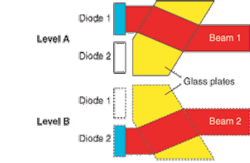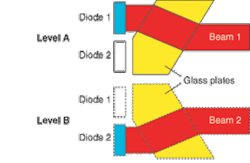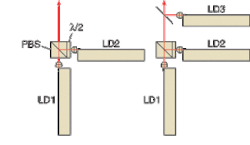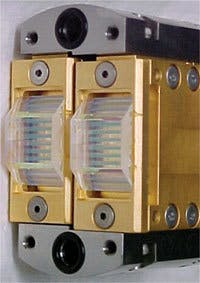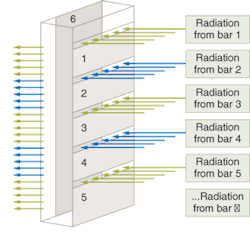HIGH-POWER SEMICONDUCTOR SOURCES: High-power diode-laser bars come of age
Semiconductor-laser bars have steadily grown in power and decreased in price per watt. Several beam-conditioning techniques are now used to increase brightness and beam quality.
MERRILL M. APTER AND FRANCK LEIBREICH
Over the past 20 years, multimode semiconductor diode-laser bars and individual single-emitter diode-laser devices have achieved higher output powers and higher power-conversion efficiencies, allowing them to transition from specialty scientific items to true industrial tools. At the same time, packaged continuous-wave (CW) diode-laser bars have decreased significantly in price from about $2000 per watt in 1987 to about $25 per watt today.
Worldwide interest in two major industrial applications (direct-diode materials processing and pump sources for industrial diode-pumped solid-state lasers) and defense has greatly influenced the historical development of high-power diode lasers. Around 1995 the German government began actively funding development of solid-state and diode lasers as part of a wide-ranging initiative to establish excellence in photonics research and industry. More recently, in the U.S., a new DARPA program called SHEDS (Super High Efficiency Diode Sources) was launched with the goal of demonstrating 80% electrical-to-optical efficiency from stacks of diode-laser bars, primarily for pumping of neodymium- and ytterbium-doped solid-state lasers. These and other programs have contributed to dramatic increases in the capabilities of diode-laser sources.
Despite this progress, deployment of high-power diode lasers into some applications still faces the fundamental challenge of transforming an inherently low-brightness, highly asymmetric source into an acceptable spatial arrangement. Several beam-shaping and beam-combining technologies have been developed and these advances, along with improvements in efficiency and reliable power-derived largely through design of epitaxial structures-have paved the way for a new generation of diode lasers with significantly higher brightness.
Applications drive brightness
Currently, diode bars (monolithic arrays of individual laser emitters) packaged on microchannel platforms operating in the near-IR can reliably produce approximately 100 W of CW output per bar. Multikilowatt CW powers can be achieved by stacking multiple bars, with further scaling possible by combining multiple stacks. While direct-diode materials processing and pumping of conventional solid-state lasers have been the primary driving forces behind the development of more-reliable higher-power diode lasers, brightness has recently emerged as the primary metric.
The need for higher-brightness fiber-coupled diode lasers for flexible beam delivery and for pumping of fiber lasers has driven renewed development and commercialization of devices that incorporate beam-transformation techniques. Three classes of these devices are available: 25-W output from a 100-µm-diameter-core fiber used in medical applications (including canine surgery and pumping lower-power fiber lasers used in the graphic-arts industry), higher-brightness devices that produce 400 W from a 400‑µm-diameter-core fiber (used for pumping industrial fiber lasers and amplifiers), and devices producing 4 kW from a 600-µm-diameter-core fiber used in other direct-diode industrial applications such as cladding and annealing.
Reliable high brightness
A variety of technical approaches have been used to reliably produce diode lasers that achieve high brightness. Today, single-emitter devices are commercially available with fiber-coupled (100‑µm-core) powers in the range of 5 to 10 W with mean time to failure in excess of 10,000 hours. This level of reliable brightness was achieved with detailed engineering of the laser die (including epitaxial design and wafer processing), thermal management, and packaging (beam conditioning, fiber coupling, and environmental control).
Cost-effective scaling of fiber-coupled powers to anywhere from several tens to thousands of watts involves the use of diode-laser bars. At kilowatt levels, multiple bars are typically stacked using modular, actively cooled platforms. Effective heat removal and package reliability depend on factors including the device geometry, coolant conditioning, and the materials chosen for components such as heat sinks, insulators, seals, and electrical contacts.1, 2 A commonly used low-thermal-resistance platform uses multilayer copper blocks with minichannels for cooling. Stacks using such heat sinks can operate reliably at CW power densities well in excess of 500 W/cm2.
Beam conditioning
While diode-laser bars are highly efficient devices, their beam quality is not as good as competing laser sources. In fact, the beam profile of a typical device is highly asymmetric: near-diffraction-limited along the fast axis (perpendicular to the semiconductor p-n junction plane) with divergence of 30° to 40° FWHM (full width at half maximum), while the slow axis (parallel to the junction plane) is many times diffraction limited (typically greater than 1000 times) with FWHM divergence of 6° to 10° (note that the beam-parameter product of a bar in this direction is essentially that of the constituent broad-area single-emitter scaled by the ratio of the bar width to the emitter width).
To achieve the highest brightness, multiple beam-conditioning techniques can be used in a single package. The simplest and most common form of beam conditioning is to collimate the fast axis with a single cylindrical lens. The light from each emitter of a bar can then be coupled into a separate fiber, with all the fibers bundled in a close-packed configuration. The relatively low divergence of the slow axis makes this technique generally compatible with fiber numerical apertures in excess of roughly 0.12.
Even with fast-axis collimation, the beam quality further degrades (typically by about a factor of two) when stacking bars in the fast-axis dimension because it is not possible to completely fill the stack aperture. Common approaches to increasing the brightness of stacks are based on spatially combining individual stacks to scale the power in a given aperture. These approaches include spatial interleaving, polarization coupling, and wavelength multiplexing.
Spatial interleaving is particularly useful because of the simplicity of implementation-for example, a pair of stacks physically offset by one-half of the bar separation are interleaved using a matched stack of refractive plates (see Fig. 1). In this example, the beam quality of the stack pair is essentially double that of an individual stack and double the brightness.
Various techniques exist for interleaving. In one, an array of prisms is separated by spacers that are used to bend one array of beams into the beam path of another array. With this technique, it is possible to generate reliable power densities well in excess of 1 kW/cm2.
Simple polarization-coupling and wavelength-multiplexing schemes are also used (see Fig. 2). In polarization coupling, the beam from one diode stack is rotated with a half-wave plate and then combined with a second beam using a polarization beam cube. In wavelength coupling, beamsplitters with wavelength-selective coatings are used to couple multiple diode sources at various wavelengths. Combining wavelength-selective optics in a prism arrangement can facilitate packaging (see Fig. 3).
A reflective beam shaper, such as one that is licensed by Spectra-Physics from the University of Southampton (Southampton, England), can be used to increase the brightness of an individual bar, or of a stack of bars, by spatially rearranging the constituent beams to reduce the aperture without increasing divergence (see Fig. 4). Beam shapers of this type can be manufactured at low cost and are easy to deploy.❏
REFERENCES
1. H. Treusch et al., Proc. SPIE3945, 23 (2000).
2. G. Treusch et al., Nonlinear Frequency Generation and Conversion: Materials, Devices, and Applications IV5711, 132 (2005).
MERRILL M. APTER is senior director of business development and FRANCK LEIBREICH is director of marketing at Spectra-Physics, a division of the Newport Corp., 1335 Terra Bella Ave., Mountain View, CA 94043; e-mail: [email protected]; www.spectra-physics.com.
